- sales/support
Google Chat: zj734465502@gmail.com
- sales
+86-0755-88291180
- sales01
sales@spotpear.com
- sales02
dragon_manager@163.com
- support
tech-support@spotpear.com
- CEO-Complaints
zhoujie@spotpear.com
- sales/support
WhatsApp:13246739196
- HOME
- >
- ARTICLES
- >
- LuckFox
- >
- Luckfox PICO
LuckFox Pico SDK1.4 configure RTL8723BS WIFI User Guide
【Basic information】
[] Only the following models are supported:Luckfox Pico Mini B /Luckfox Pico Plus /Luckfox Pico Pro /Luckfox Pico Max
[] Not supported:Luckfox PicoOther models in the series
[] Module model: LF-WIFI (A) module developed by Banli Electronics based on RTL8723BS
[] SDK used: Luckfox SDK V1.4
[] Source code address:https://github.com/LuckfoxTECH/luckfox-pico.git
】Hardware Introduction
[] RTL8723BS is a module that integrates Bluetooth and WIFI.
[]LF-WIFI (A) module: It is a module based on RTL8723BS for secondary development. It has a TF card slot shape and is driven by the SDIO interface. Due to the interface limitations of SDIO, this module only uses the RTL8723BS WIFI function and does not use the Bluetooth function.
】TF card interface hardware schematic diagram
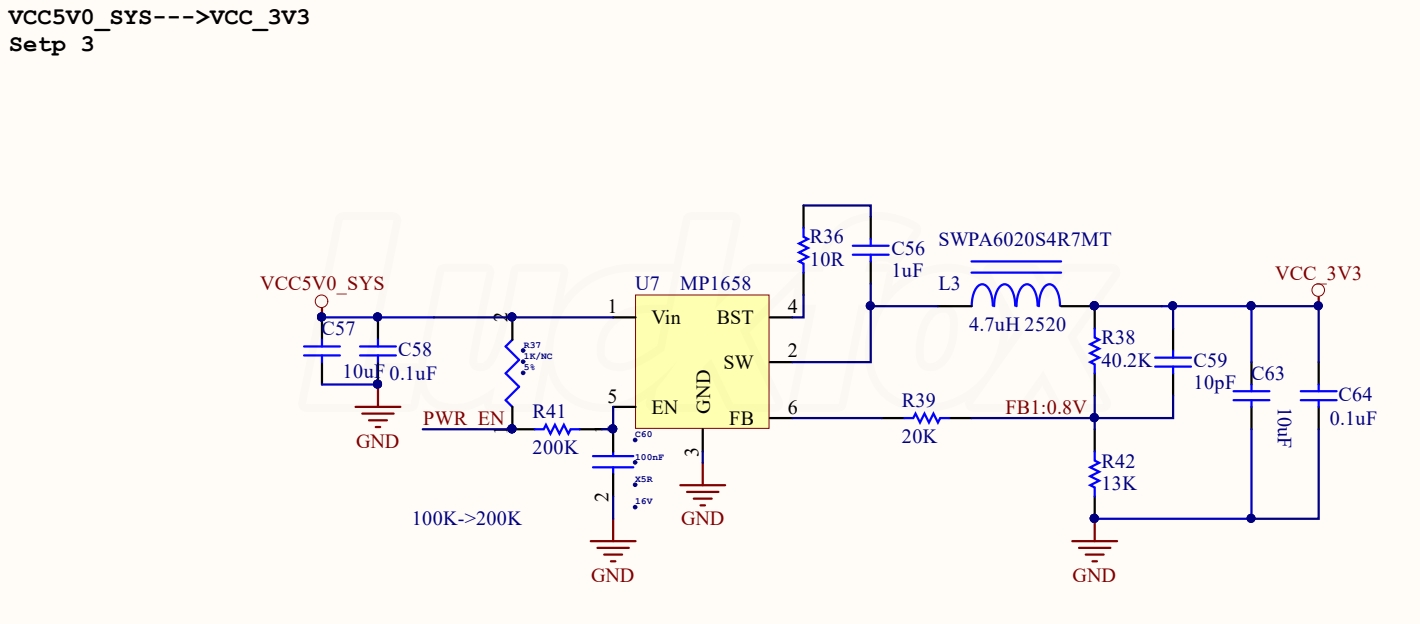
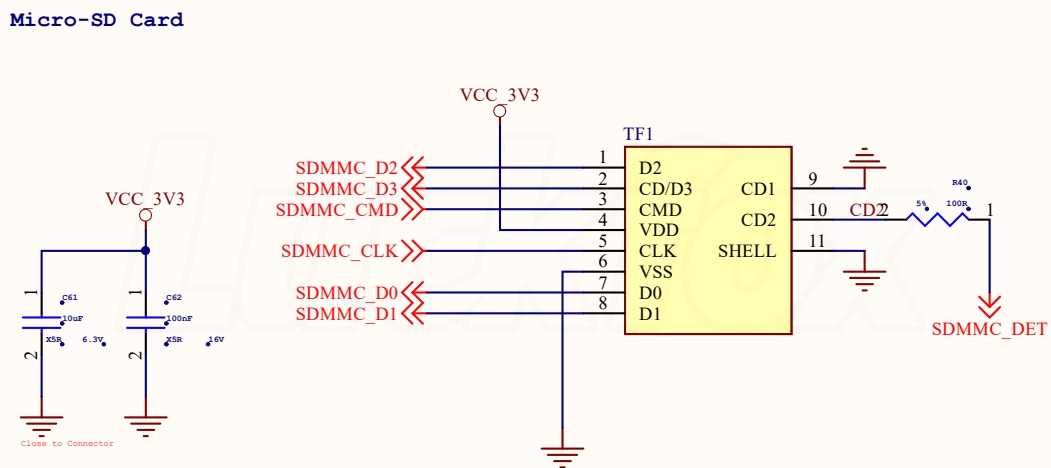
】LF-WIFI (A) schematic diagram
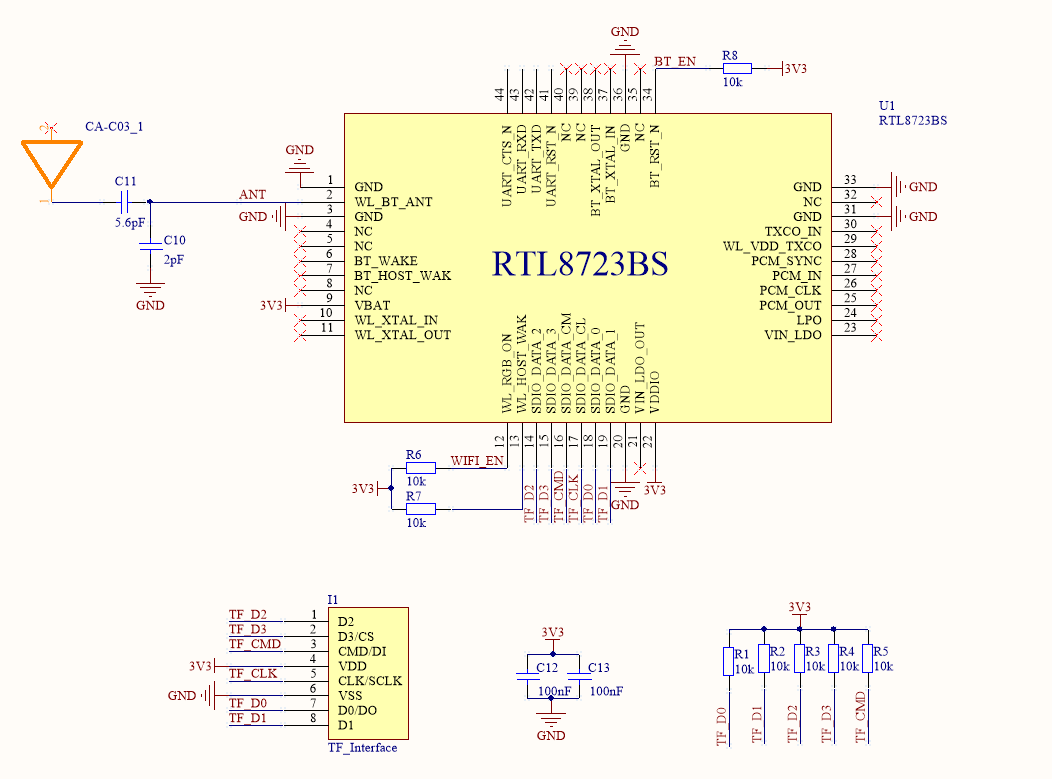
Pin 12 (WL_DSI/WL_REG) is pulled high.
Pin 13 (WL_HOST_WAKE) is pulled high.
【Pre-configured images】
【Install the driver yourself (based on SDK1.4)】
Note: This tutorial uses the Luckfox Pico Max as an example!
】Step 1 Modify the kernel
Content that needs to be modified
Type :Kernel WiFi Driver Support
File Path:<SDK Directory>/sysdrv/source/kernel/arch/arm/configs/luckfox_rv1106_linux_defconfig
Configuring WIFI requires modifying the kernel. Rockchip can directly modify the kernel to support WIFI function. You can directly open the kernel configuration interface through the command ./build.sh kernelconfig in the SDK root directory.
[] Notice
"M" Indicates that it is loaded into the system kernel as a module
" * " Indicates direct compilation into the kernel
(kernelconfig Tutorial:https://wiki.luckfox.com/zh/Luckfox-Pico/Luckfox-Pico-SDK/)
[] kernelconfig Instructions to configure the kernel
cd <sdk>/path
sudo ./build.sh kernelconfig
[] Kernel configuration turns on cfg80211
Select:Networking support > Wireless >{M} cfg80211 - wireless configuration API
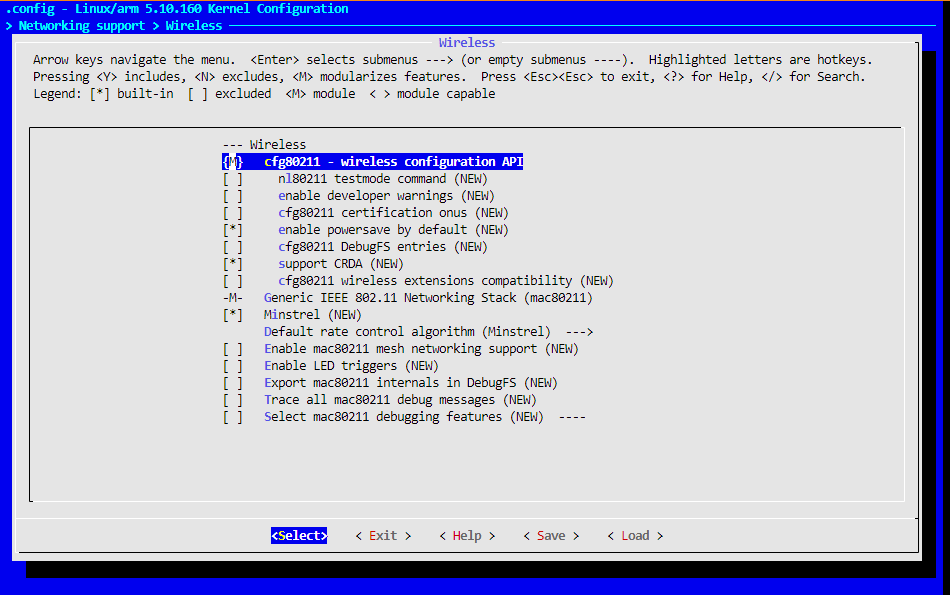
[] Kernel configuration enabled build wifi ko modules
Select:Device Drivers > Network device support > Wireless LAN > Rockchip Wireless LAN support > [*] build wifi ko modules
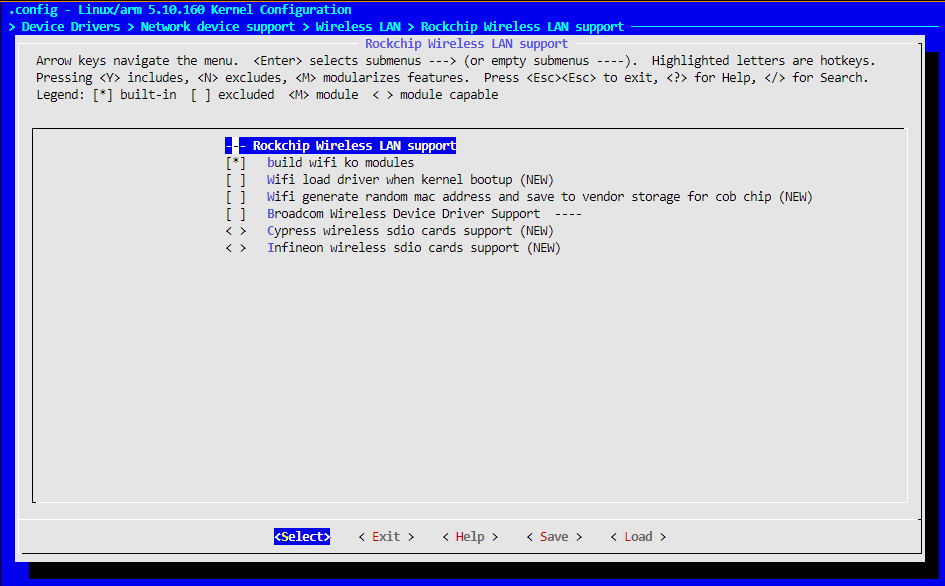
[] Kernel configuration to enable RTL8723BS SDIO driver
Select:Device Drivers > Staging drivers > <M>Realtek RTL8723BS SDIO Wireless LAN NIC driver
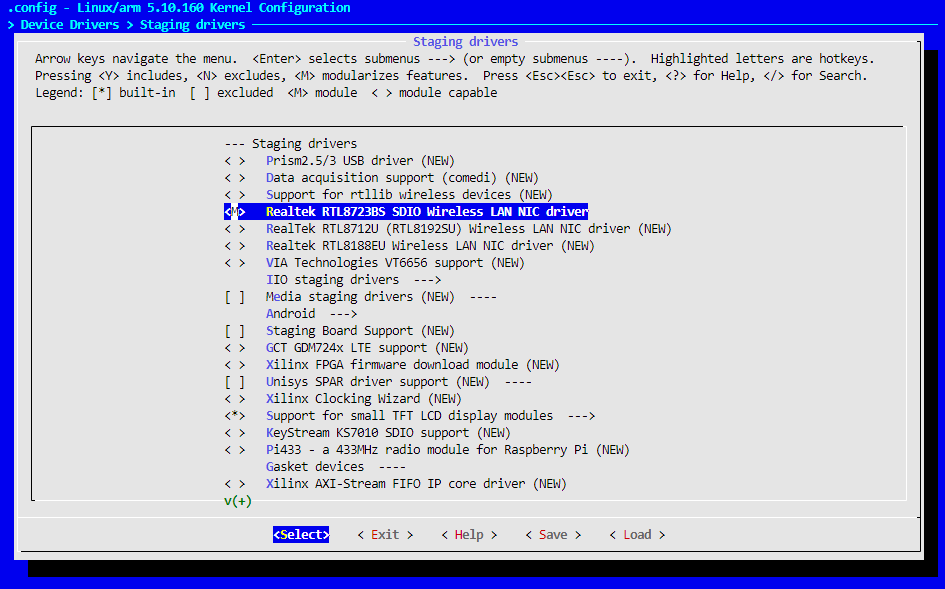
】Step 2 Add buildroot package
To modify buildroot, you can use the command ./build.sh buildrootconfig, which is newly added to the 1.3 version of the SDK. Its goal is to simplify the build process of embedded Linux systems. By configuring Buildroot, you can customize the software packages and libraries included in the embedded system to meet specific needs.
(buildrootconfig Tutorial:SDK environment deployment (X86_64 platform) | LUCKFOX WIKI)
Add iw (optional) software package
Select:Target packages > Networking applications > [*] iw

[] Add wpa_supplicant package
Select: Target packages > Networking applications > wpa_supplicant > check all options under wpa_supplicant
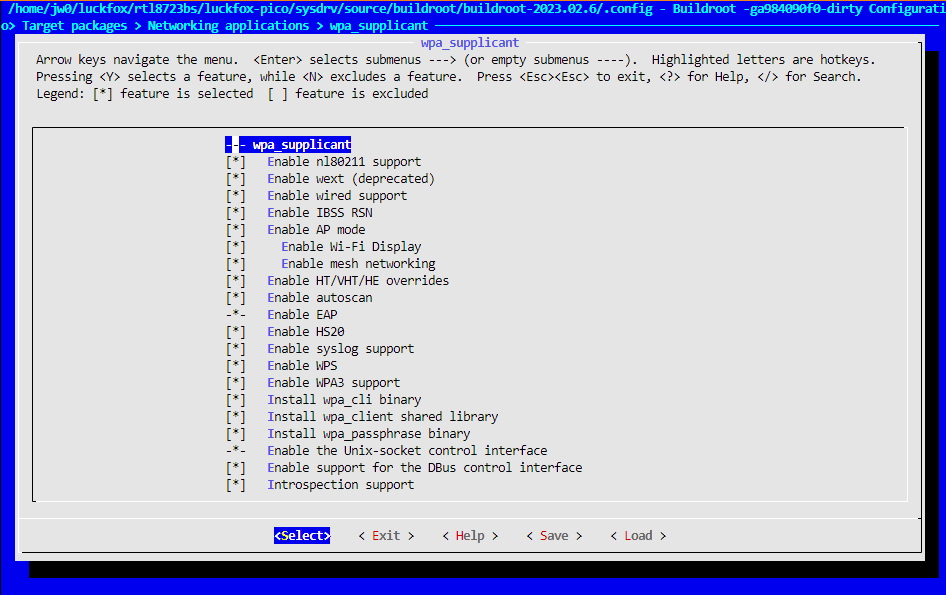
The compiled wpa_supplicant source program mainly includes two executable tools: wpa_supplicant and wpa_cli.
explain:
wpa_supplicant:It runs in the background as a core service program, handling tasks such as authentication and encryption of network connections.
wpa_cli:As a client tool of wpa_supplicant, users can send commands to wpa_supplicant through wpa_cli to implement network configuration, scanning, connection and other operations.
[] Add wireless tools package
Select:Target packages > Networking applications > [*] wireless tools

explain:
Wireless Tools: It is a wireless management software tool set for Linux. It helps users configure and manage wireless devices that support Wireless Extension by providing a set of simple and easy-to-use command line tools.
Notice:
Do not clean after configuring buildroot, otherwise the above configuration will be cleared.
If you use the command ./build.sh buildrootconfig, it will be saved automatically. Then, go to the buildroot folder and make all the software packages to download. After downloading, it will also speed up the compilation of the SDK.
】Step 3 Modify the device tree
Content that needs to be modified
Device | Type | File Path |
Luckfox Pico Max | Main Device Tree | <SDK Directory>/sysdrv/source/kernel/arch/arm/boot/dts/rv1106g-luckfox-pico-max.dts |
Luckfox Pico Pro | <SDK Directory>/sysdrv/source/kernel/arch/arm/boot/dts/rv1106g-luckfox-pico-pro.dts | |
Luckfox Pico Plus | <SDK Directory>/sysdrv/source/kernel/arch/arm/boot/dts/rv1103g-luckfox-pico-plus.dts | |
Luckfox Pico Mini B | <SDK Directory>./sysdrv/source/kernel/arch/arm/boot/dts/rv1103g-luckfox-pico-mini.dts
|
Device | Type | File Path |
Luckfox Pico Max | Include Device Tree | <SDK Directory>/sysdrv/source/kernel/arch/arm/boot/dts/rv1106-luckfox-pico-pro-max-ipc.dtsi |
Luckfox Pico Pro | ||
Luckfox Pico Plus | <SDK Directory>/sysdrv/source/kernel/arch/arm/boot/dts/rv1103-luckfox-pico-ipc.dtsi | |
Luckfox Pico Mini B |
Modify the device tree
Edit rv1106g-luckfox-pico-max.dts device tree
sudo nano <SDK>/sysdrv/source/kernel/arch/arm/boot/dts/rv1106g-luckfox-pico-max.dts
Add code
vcc_1v8: vcc-1v8 {
compatible = "regulator-fixed";
regulator-name = "vcc_1v8";
regulator-always-on;
regulator-boot-on;
regulator-min-microvolt = <1800000>;
regulator-max-microvolt = <1800000>;
};
vcc_3v3: vcc-3v3 {
compatible = "regulator-fixed";
regulator-name = "vcc_3v3";
regulator-always-on;
regulator-boot-on;
regulator-min-microvolt = <3300000>;
regulator-max-microvolt = <3300000>;
};
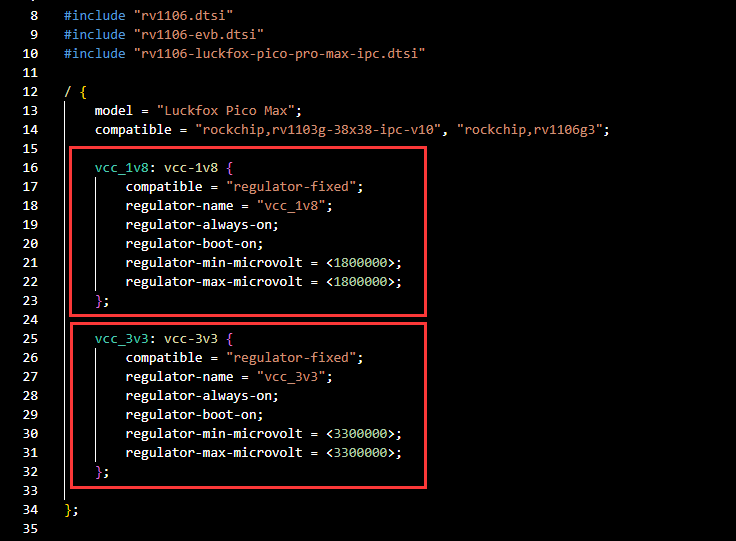
Change "&sdmmc" to
&sdmmc {
max-frequency = <50000000>;
bus-width = <4>;
cap-sd-highspeed;
cap-sdio-irq;
keep-power-in-suspend;
non-removable;
sd-uhs-sdr50;
no-1-8-v;
supports-sdio;
pinctrl-names = "default";
pinctrl-0 = <&sdmmc0_clk &sdmmc0_cmd &sdmmc0_det &sdmmc0_bus4>;
status = "okay";
};
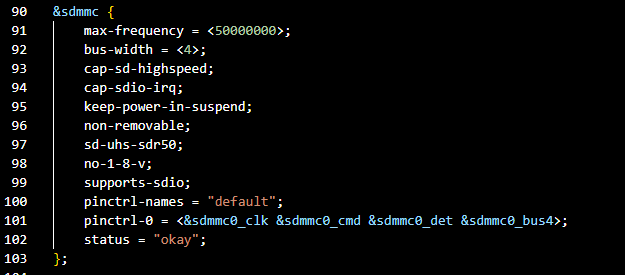
Change "&gmac" to
&gmac {
status = "disabled";
};

Edit rv1106-luckfox-pico-pro-max-ipc.dtsi device tree
sudo nano <SDK>/sysdrv/source/kernel/arch/arm/boot/dts/rv1106-luckfox-pico-pro-max-ipc.dtsi
Add "&sfc" code
&sfc {
status = "okay";
flash@0 {
compatible = "spi-nand";
reg = <0>;
spi-max-frequency = <80000000>;
spi-rx-bus-width = <4>;
spi-tx-bus-width = <1>;
};
};
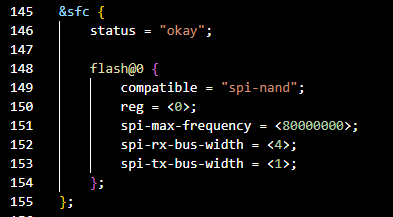
】Step 4 Enable WIFI
[] Content that needs to be modified
| Type | File Path |
Luckfox Pico Max | SDK Global Configuration | <SDK Directory>/project/cfg/BoardConfig_IPC/BoardConfig-SPI_NAND-Buildroot-RV1106_Luckfox_Pico_Max-IPC.mk |
Luckfox Pico Pro | <SDK Directory>/project/cfg/BoardConfig_IPC/BoardConfig-SPI_NAND-Buildroot-RV1106_Luckfox_Pico_Pro-IPC.mk | |
Luckfox Pico Plus | <SDK Directory>/project/cfg/BoardConfig_IPC/BoardConfig-SPI_NAND-Buildroot-RV1103_Luckfox_Pico_Plus-IPC.mk | |
Luckfox Pico Mini B | <SDK Directory>/project/cfg/BoardConfig_IPC/BoardConfig-SPI_NAND-Buildroot-RV1103_Luckfox_Pico_Mini_B-IPC.mk |
Edit rv1106-luckfox-pico-pro-max-ipc.dtsi device tree
sudo nano <SDK>/project/cfg/BoardConfig_IPC/BoardConfig-SPI_NAND-Buildroot-RV1106_Luckfox_Pico_Max-IPC.mk
Add the following content
#enable wifi
export RK_ENABLE_WIFI=y
】Step 5 Modify the global build script
Content that needs to be modified
Type | File Path |
Global Build Script | <SDK Directory>/project/build.sh |
Generate firmware configuration for WiFi driver (rtl8723bs)
sudo nano <SDK>/project/build.sh
Add (or uncomment) the following to the function build_app()
build_meta --export --media_dir $RK_PROJECT_PATH_MEDIA # for rtl8723bs

Copy the contents of the external directory in the SDK to the build directory of the root file system (rootfs)
Add (or uncomment) the following to function __PACKAGE_ROOTFS()
__COPY_FILES $SDK_ROOT_DIR/external $RK_PROJECT_PACKAGE_ROOTFS_DIR
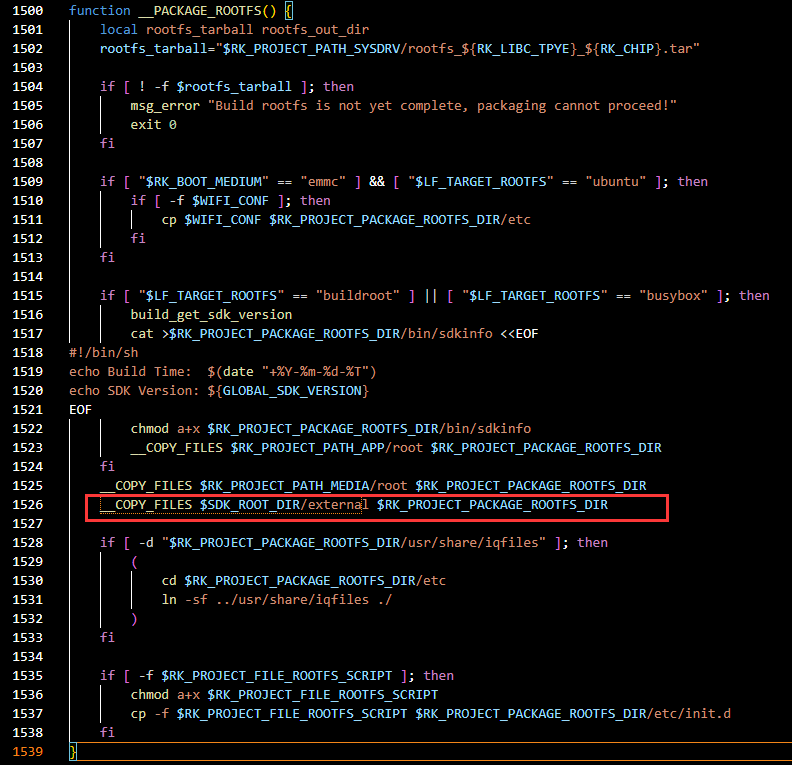
】Step6 Add rtl8723bs firmware to SDK
Create a folder in the SDK root directory
mkdir -p external/lib/firmware/rtlwifi/
Download rtl8723bs wifi firmware
wge thttps://raw.githubusercontent.com/wkennington/linux-firmware/master/rtlwifi/rtl8723bs_nic.bin
Copy the rtl8723bs firmware to the sdk/external/lib/firmware/rtlwifi/ directory
cp rtl8723bs_nic.bin sdk/external/lib/firmware/rtlwifi/
】Step7 Compile SDK
Specified development board
luckfox@luckfox:~/luckfox-pico$ ./build.sh lunch
Execute Compilation
luckfox@luckfox:~/Luckfox-Pico/luckfox-pico$ ./build.sh
【Step8 WiFi Test】
】Manually test wifi
[] Install the driver module
cd /oem/usr/ko
insmod libarc4.ko
insmod cfg80211.ko
insmod mac80211.ko
insmod r8723bs.ko

Under normal circumstances, ifconfig -a can be used to see the wlan0 device
ifconfig -a

】Turn on Wi-Fi
ifconfig wlan0 up

View surrounding networks
iwlist wlan0 scan
The surrounding network information will be displayed in turn.
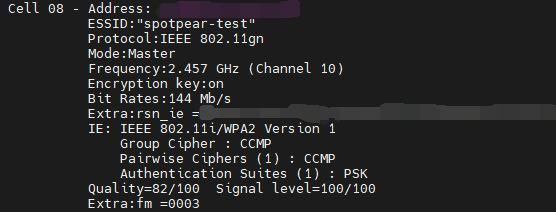
Notice:Here we take the wifi with ESSID spotpear-test as an example!
】Configure Wi-Fi file
Edit wpa_supplicant.conf file
vi /etc/wpa_supplicant.conf
Modify to your own wifi settings as needed
ctrl_interface=/var/run/wpa_supplicant
ctrl_interface_group=0
ap_scan=1
network={
ssid="YOUR_SSID"
key_mgmt=WPA-PSK
pairwise=CCMP TKIP
group=TKIP CCMP
psk="YOUR_PWD"
}
explain:
ssid="YOUR_SSID" is the user's WIFI name
psk="YOUR_PWD" is the user's WiFi password

】Create a socket file
mkdir -p /var/run/wpa_supplicant
This file is created to allow wpa_supplicant (Wi-Fi authentication client) to work properly.
】Connect to WIFI
wpa_supplicant -B -c /etc/wpa_supplicant.conf -i wlan0

】Configuring Dynamic IP
udhcpc -i wlan0

】Configuring Static IP
Or you can choose to configure a static IP
ifconfig wlan0 192.168.xxx.xxx netmask 255.255.255.0 up
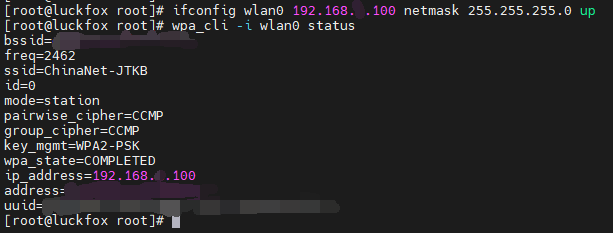
】View connection status
wpa_cli -iwlan0 status
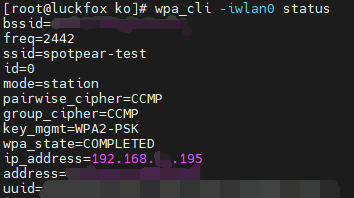
You can see above that wpa_state=COMPLETED, which means the connection is successful and the IP address is output.
【Automatically test Wi-Fi】
】Method 1: Add a new auto-start script in the firmware
Add the S98wifi_auto_connect script file in the /etc/init.d/ directory of the firmware
nano /etc/init.d/S98wifi_auto_connect
Add the following content:
#!/bin/sh
### BEGIN INIT INFO
# Provides: wifi_auto_connect
# Required-Start: $network
# Default-Start: S
# Default-Stop: 0 6
### END INIT INFO
WLAN_IF="wlan0"
load_wifi_modules() {
echo "Loading Wi-Fi driver modules..."
cd /oem/usr/ko || exit 1
insmod libarc4.ko
insmod cfg80211.ko
insmod mac80211.ko
insmod r8723bs.ko
}
start_wifi() {
sleep 4
echo "Bringing up Wi-Fi interface..."
ifconfig $WLAN_IF up
mkdir -p /var/run/wpa_supplicant
wpa_supplicant -B -c /etc/wpa_supplicant.conf -i $WLAN_IF
}
get_ip_address() {
echo "Requesting IP address via DHCP..."
#udhcpc -i $WLAN_IF
#ifconfig $WLAN_IF 192.168.xxx.xxx netmask 255.255.255.0 up
}
case "$1" in
start)
echo "Starting Wi-Fi auto-connect..."
load_wifi_modules
# 检查 wlan0 是否存在
if ip link show $WLAN_IF >/dev/null 2>&1; then
start_wifi
sleep 5 # 给 wpa_supplicant 时间连接
get_ip_address
else
echo "Error: $WLAN_IF not found"
fi
;;
stop)
echo "Stopping Wi-Fi..."
killall wpa_supplicant
ifconfig $WLAN_IF down
;;
*)
echo "Usage: $0 {start|stop}"
exit 1
;;
esac
Ctrl+O to save, Ctrl+X to exit
Grant permissions to the S98wifi_auto_connect script
chmod 775 /etc/init.d/S98wifi_auto_connect
Restart to take effect
】Method 2: Add a new auto-start script in SDK
sudo nano <SDK>project/cfg/BoardConfig_IPC/overlay/overlay-luckfox-buildroot-init/etc/init.d/S98wifi_auto_connect
Add the following content:
#!/bin/sh
### BEGIN INIT INFO
# Provides: wifi_auto_connect
# Required-Start: $network
# Default-Start: S
# Default-Stop: 0 6
### END INIT INFO
WLAN_IF="wlan0"
load_wifi_modules() {
echo "Loading Wi-Fi driver modules..."
cd /oem/usr/ko || exit 1
insmod libarc4.ko
insmod cfg80211.ko
insmod mac80211.ko
insmod r8723bs.ko
}
start_wifi() {
sleep 4
echo "Bringing up Wi-Fi interface..."
ifconfig $WLAN_IF up
mkdir -p /var/run/wpa_supplicant
wpa_supplicant -B -c /etc/wpa_supplicant.conf -i $WLAN_IF
}
get_ip_address() {
echo "Requesting IP address via DHCP..."
#udhcpc -i $WLAN_IF
#ifconfig $WLAN_IF 192.168.xxx.xxx netmask 255.255.255.0 up
}
case "$1" in
start)
echo "Starting Wi-Fi auto-connect..."
load_wifi_modules
# 检查 wlan0 是否存在
if ip link show $WLAN_IF >/dev/null 2>&1; then
start_wifi
sleep 5 # 给 wpa_supplicant 时间连接
get_ip_address
else
echo "Error: $WLAN_IF not found"
fi
;;
stop)
echo "Stopping Wi-Fi..."
killall wpa_supplicant
ifconfig $WLAN_IF down
;;
*)
echo "Usage: $0 {start|stop}"
exit 1
;;
esac
Restart compiling SDK
sudo <SDK>/build.sh lunch
sudo <SDK>/build.sh
Notice:
Since the dynamic IP is configured in the S98wifi_auto_connect script, the user will not be able to enter the system through the serial terminal if the network is abnormal after restart. Therefore, the function of configuring dynamic IP is blocked in the S98wifi_auto_connect script.
Since the user's gateway address is not clear, the function of configuring a static IP is also blocked. Users need to configure a dynamic IP or a static IP by themselves.
【WIFI connection SSH and camera】
Refer to the luckfox official ssh and camera tutorial. After ifconfig finds the corresponding WIFI IP, except that you need to change the WIFI corresponding IP, the other steps are exactly the same as the official tutorial.
[Tutorial Navigation]
- 【Basic information】
- 【Pre-configured images】
- 【Install the driver yourself (based on SDK1.4)】
- 】Step 1 Modify the kernel
- [] Notice
- [] kernelconfig Instructions to configure the kernel
- [] Kernel configuration turns on cfg80211
- [] Kernel configuration enabled build wifi ko modules
- [] Kernel configuration to enable RTL8723BS SDIO driver
- 】Step 2 Add buildroot package
- 】Step 3 Modify the device tree
- 】Step 4 Enable WIFI
- 】Step 5 Modify the global build script
- 】Step6 Add rtl8723bs firmware to SDK
- 】Step7 Compile SDK
- 【Step8 WiFi Test】
- 】Manually test wifi
- 】Turn on Wi-Fi
- 】Configure Wi-Fi file
- 】Create a socket file
- 】Connect to WIFI
- 】Configuring Dynamic IP
- 】Configuring Static IP
- 】View connection status
- 【Automatically test Wi-Fi】
- 【WIFI connection SSH and camera】




